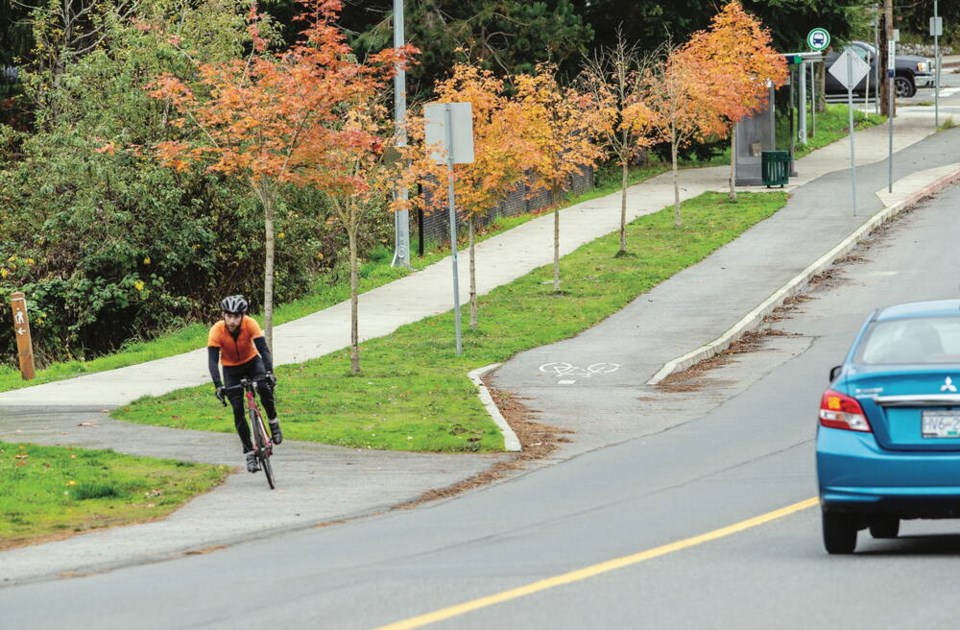While Victoria continues to build a cycling network of connected routes designed for all ages and abilities, bike infrastructure outside the core remains a mixed bag of unconnected and unprotected lanes, a cycling advocate says.
There are only short “bits and pieces” of protected lanes outside Victoria that lead to unprotected lanes or no bike lanes at all, leaving cyclists more vulnerable to vehicles on the road, said Corey Burger, policy and infrastructure chair of Capital Bike.
That means bike commuters outside Victoria are often sharing a lane with high-speed vehicle traffic or relying on a painted line to keep them safe.
“At its worst, it can be truly terrible,” Burger said.
Colwood Coun. Cynthia Day recently tried to add protected bike lanes to a redesign of Veterans Memorial Parkway and Wishart Road, but her proposal was shot down by other councillors.
Coun. Stewart Parkinson said the October meeting was the first time he had heard about the idea, and there is lots of time for changes before the project is complete. The redesign, which will add two lanes to Veterans Memorial Parkway between Latoria Road and Cairndale Road, could end up including protected bike lanes, Parkinson said. The design currently includes painted bike lanes with a buffer space between the lane and vehicle lanes.
“The road we’re talking about isn’t going to get built for, gosh, 10, 15 years, so there’s no rush to make that decision,” he said. “I’m a big fan of trying to get our vital infrastructure right. And going from the right places to the right places. I just didn’t see the sense of jumping to a conclusion at the meeting.”
Colwood resident Dave Lacey bikes regularly with his two children, and says his eight-year-old daughter sometimes feels nervous being close to vehicles and needs to ride on the sidewalk.
“That’s a really sad part of it, as a parent. Not to have anything that she feels safe on is tough,” he said.
Lacey said painted lanes aren’t going to encourage new riders, because many people don’t feel safe using them.
Burger said that while about half the region’s arterial roads have a bike lane, only one per cent are physically separated from traffic.
Each municipality has its own approach and challenges when it comes to building bike infrastructure, including small budgets and sparse populations, he said. Langford has built many bike lanes relative to other cities, but they’re not protected and the municipality is building them to minimum design guidelines, which only require a width of 1.5 metres, Burger said.
When they’re next to motor vehicle lanes that are also minimum widths, that leaves little wiggle room to eventually upgrade to protected lanes, he said.
In Colwood, new bike lanes are often painted lines on the road, with a second line outside the lane creating a buffer between bikes and cars. Burger wants to see that standard upgraded to include bollards or a similar physical separation from cars.
While municipalities beyond Victoria haven’t quite reached the point where they’re building connected networks of cycling infrastructure, some, like Saanich and Esquimalt, are planning those networks, said Burger, who believes every municipality will eventually build all ages and abilities infrastructure.
“It’s really about how fast they get there,” he said.
City planning has moved past an era where roads were redesigned without accommodating bicycles, Burger said. Now, municipalities are under pressure to ensure those lanes are separated from motor vehicles.
“We know now that if you don’t build a protected bike lane, you aren’t gonna get the numbers out. You won’t get the diversity as well. You won’t see kids and families. You won’t see people like seniors who might be getting back on a bike for the first time in a while,” he said.
Big changes aren’t likely to come quickly, however. Burger said parents often ask when they’ll be able to safely bike to school with their children. “Probably not with your kid while your kid’s still a kid,” he tells them.
What it takes is the political will on municipal councils to push for better cycling infrastructure, Burger said. He expects to see a snowball effect once the first few protected bike lanes outside the core are built.
Victoria’s growing network is already upping the pressure on other municipalities, as people come downtown from the suburbs, ride the protected bike lanes and start to advocate to their councils for similar infrastructure, he said.



